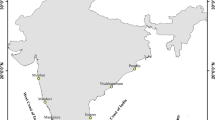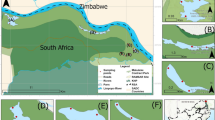Abstract
Investigations on periphyton along an eutrophication gradient (NO3 − = 0.23−0.96 mg L−1; PO −34 = 0.16−0.86 mg L−1) of Ganga River indicated that benthic algal biomass decreased with increasing concentrations of nutrients and dissolved organic carbon (DOC). Periphyton biomass showed negative relationship (R 2 = 0.98; p < 0.0001) with DOC and positive relationship (R 2 = 0.96; p < 0.0001) with Secchi depth. Sites with high DOC showed dominance of cyanophycean Phormidium uncinatum. The study shows that the rising concentration of DOC over time may alter the light climate and consequently the fate of benthic primary producers in Ganga River.


Similar content being viewed by others
References
APHA (1998) Standard methods for the examination of water and wastewater. American Public Health Association, Washington, DC
Bergstrom AK, Jansson M, Blomqvist P, Drakare S (2001) The influence of water colour and effective light climate on mixotrophic phytoflagellates in three small Swedish dystrophic lakes. Int Assoc Theor Appl Limnol 27:1861–1865
Biggs BJF, Kilroy C (2000) Stream periphyton monitoring manual. NIWA, Christchurch
Carey RO, Vellidis G, Lowrance R, Pringle CM (2007) Do nutrient limit algal periphyton in small black-water coastal plain streams. J Am Water Resour Assoc 5:1183–1193
Elser JJ, Fagan FW, Denno RF, Dobberfuhl DR, Folarin A, Huberty A, Interlandi S, Kilham SS, Mc Cauley E, Schulz KL, Siemann EH, Sterner RW (2000) Nutritional constraints in terrestrial and freshwater food webs. Nature 408:578–580
Evans CD, Chapman PJ, Clark JM, Monteith DT, Cresser MS (2006) Alternative explanations for rising dissolved organic carbon export from organic soils. Glob Change Biol 12:2044–2053
Karlsson J, Bystrom P, Ask J, Ask P, Persson L, Jansson M (2009) Light limitation of nutrient-poor lake ecosystems. Nature 460:506–509
Luijn FV, van der Molen DT, Luttmer WJ, Boers PCM (1995) Influence of benthic diatoms on the nutrient release from sediments of shallow lakes recovering from eutrophication. Water Sci Technol 32:89–97
Mackereth FJH (1963) Some methods of water analysis for limnologists, vol 21. Freshwater Biological Association, Amleside
Maiti SK (2001) Handbook of methods in environmental studies (Vol.1,Water and Wastewater). ABD Publisher, Jaipur
McEachern P, Prepas EE, Gibson JJ, Dinsmore WP (2000) Forest fire induced impacts on phosphorus, nitrogen and chlorophyll a concentrations in boreal subarctic lakes of northern Alberta. Can J Fish Aquat Sci 57:73–81
Michel P (1984) Ecological methods for field and laboratory investigation. Tata McGraw–Hill Publ Comp, New Delhi, India
Pandey J, Pandey U (2009) Microbial processes at land water interface and cross-domain causal relationships as influenced by atmospheric deposition of pollutants in three freshwater lakes in India. Lakes Reserv: Res Manag 14:71–84
Pandey U, Pandey J (2012) Impacts of DOC trends resulting from changing climatic extremes and atmospheric deposition chemistry on periphyton community of a freshwater tropical lake of India. Biogeochemistry. doi:10.1007/s10533-012-9747-7
Vadeboncoeur Y, Jeppesen E, Zanden MJV, Schierup H-H, Christoffersen K, Lodge DM (2003) From Greenland to green lakes: cultural eutrophication and the loss of benthic pathways in lakes. Limnol Oceanogr 48:1408–1418
Voghe AL (1971) A text book of quantitative inorganic analysis, 4th edn. The English Language Book Society/Longman, Essex
Yang Y, He Z, Lin Y, Philips EJ, Yang J, Chem G, Stoffella PJ, Powell CA (2008) Temporal and spatial variations of nutrients in the Ten Mile Creek of South Florida, USA and effects on phytoplankton. J Environ Monit 4:508–516
Author information
Authors and Affiliations
Corresponding author
Rights and permissions
About this article
Cite this article
Pandey, U. The Influence of DOC Trends on Light Climate and Periphyton Biomass in the Ganga River, Varanasi, India. Bull Environ Contam Toxicol 90, 143–147 (2013). https://doi.org/10.1007/s00128-012-0879-1
Received:
Accepted:
Published:
Issue Date:
DOI: https://doi.org/10.1007/s00128-012-0879-1




